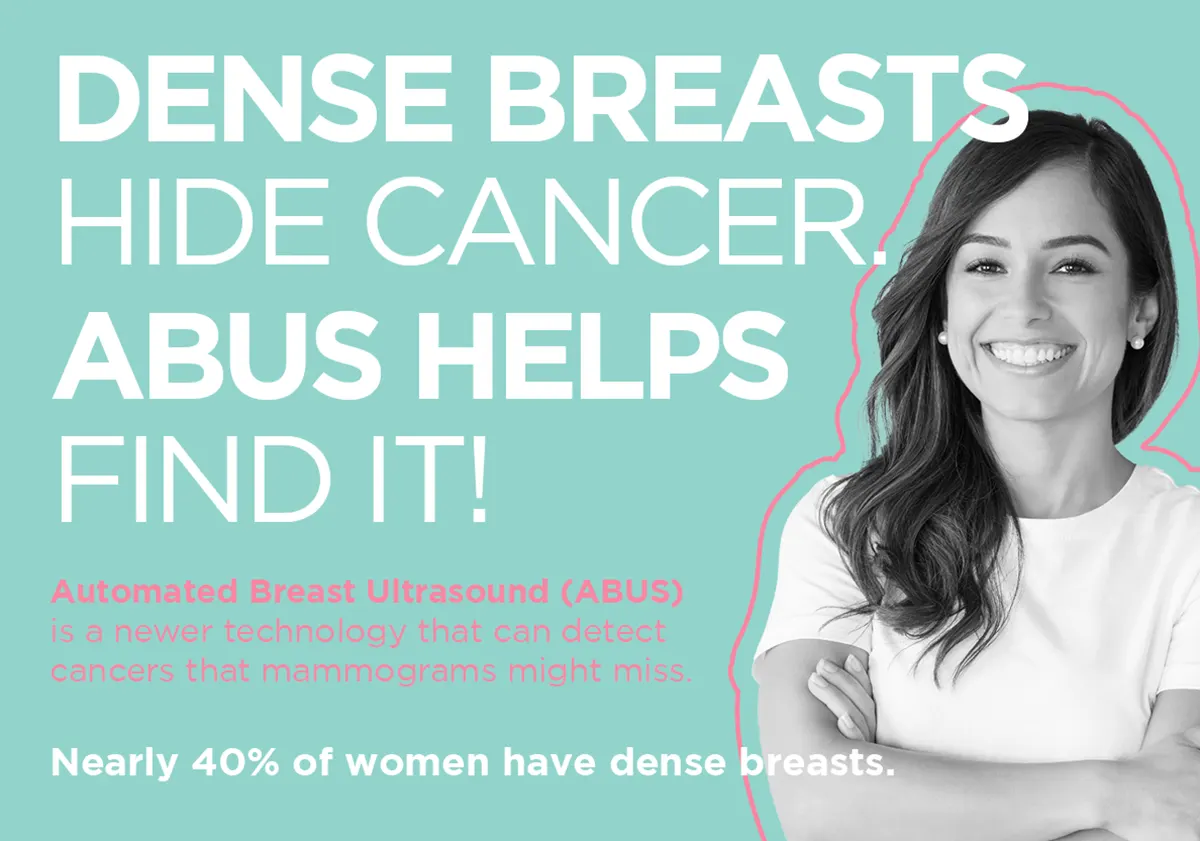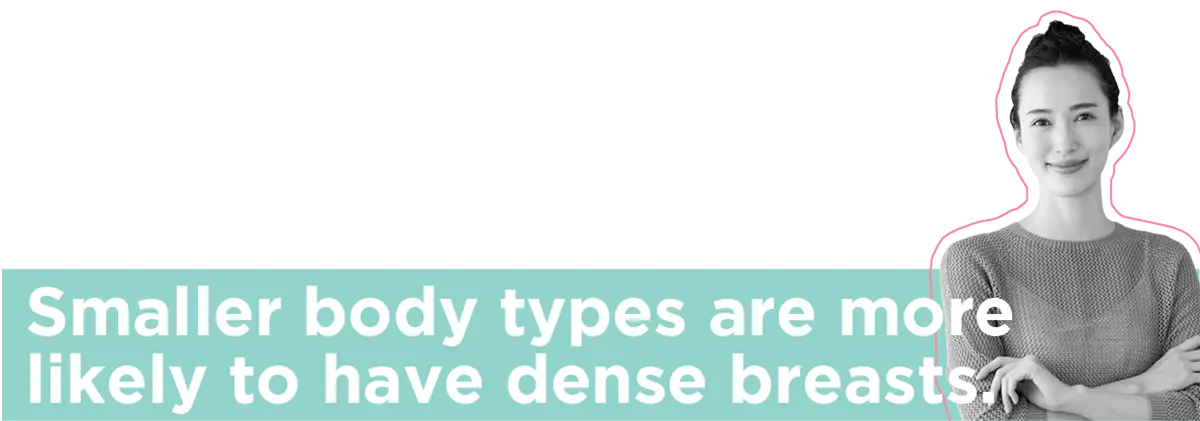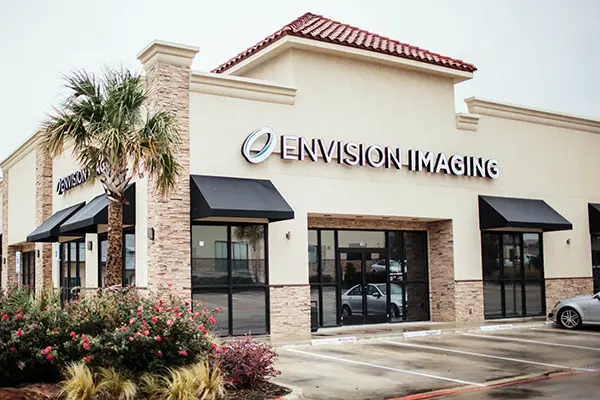What is an Automated Breast Ultrasound (ABUS)?
For millions of women with dense breast tissue, routine mammograms may not tell the whole story. In fact, density can mask up to one-third of breast cancers on a traditional mammogram.
But one technology is changing that: Automated Breast Ultrasound (ABUS).
Request Your ABUS ExamSpecifically designed to supplement mammography for women with dense breasts, ABUS helps radiologists see what might otherwise go unnoticed earlier and more accurately.
Let’s take a closer look.
Understanding Breast Density
Breast tissue is made up of a mix of fatty and fibroglandular (dense) tissue. When a woman has more dense tissue than fat, she is said to have dense breasts.
This is not unusual.
About 40% of women in the U.S. fall into this category. On a mammogram, dense tissue and cancer both appear white, making it difficult for radiologists to distinguish between them.
The problem? Cancers can be hidden in the background, leading to delayed diagnosis.
This doesn’t mean mammograms are ineffective. They’re still the gold standard for breast cancer screening.
But for women with dense breasts, mammography alone may not be enough.

What Is ABUS?
Automated Breast Ultrasound (ABUS) is a supplemental screening tool cleared by the FDA for women with dense breast tissue and a normal mammogram.
Unlike handheld ultrasound, which is highly dependent on the technologist’s skill and can vary from patient to patient, ABUS utilizes a wide, automated transducer to capture detailed 3D images of the entire breast in consistent, standardized views.
The advantages of this technology? There are quite a few:
- Operator-independent scanning
- High-resolution coronal images (which allow radiologists to “scroll” through layers of breast tissue)
- Gentle, comfortable compression
- Rapid image acquisition and reading times
- Built-in software that enhances workflow and consistency
It’s a win-win all around.
The Evidence Behind ABUS
Let’s talk results.
Multiple clinical studies support ABUS as an effective supplement to mammography.
In the landmark SomoInsight trial, ABUS increased cancer detection rates by 55% in women with dense breasts. These were often small, invasive, and node-negative cancers, the kind of early-stage findings that change outcomes.
And there’s more.
In a European study of ABUS 2.0, researchers found a 57% increase in detection, all while maintaining a low recall rate (2.3%). This means ABUS adds value without contributing to a flood of unnecessary follow-ups.
Still not convinced?
Real-world cases confirm the data. Women with normal mammograms were later found to have invasive ductal carcinoma through ABUS imaging, lesions that would have gone undetected until they had grown or spread.

Who Should Consider ABUS?
ABUS is not a replacement for mammography – it’s a complement. It is best suited for:
- Women with dense breast tissue (BI-RADS category C or D)
- Those with no current symptoms and a normal or benign mammogram (BI-RADS 1 or 2)
- Individuals who want added peace of mind and a more complete view of their breast health
For women in these categories, ABUS offers a non-invasive, radiation-free way to dig deeper without compromising comfort or time.
Better Detection Means Better Treatment
Here’s the bottom line:
Catching breast cancer early opens up more options and often leads to less aggressive treatment. When cancers are small and confined to the breast (and lymph nodes are unaffected), many patients can avoid chemotherapy or mastectomy and opt for lumpectomy and radiation instead.
ABUS helps make this early intervention possible.
By improving detection rates in women with dense breasts, ABUS contributes directly to better prognoses, fewer late-stage cancers, and therefore more lives saved.
Why Mammograms Matter Despite the Benefits of ABUS
In light of this new, powerful technology, you might be asking yourself, “Why do I still need to get a mammogram when I could just get a breast ultrasound instead?”
Though ABUS is more precise than mammography, the latter continues to be the touchstone of breast health services.
The reason?
There are some cancers that only show up on mammograms, despite the obstacle of dense breasts. What’s more, mammograms observe the whole breast area, whereas ultrasounds analyze a specific part.
Empowering Radiologists and Patients
The tech is impressive, but so is the support behind it.
GE HealthCare’s Invenia™ ABUS system is one of the leading technologies in this space, and the ABUS Club website serves as a hub for education resources and clinical information.
Here’s what’s available:
- Radiologists can access case libraries, white papers, marketing tools, and interactive modules to build confidence and consistency.
- Patient-facing materials like brochures, videos, and posters help demystify the screening experience and encourage informed decision-making.
The tools are there. The support is there.
All that’s left is to take the next step.

The Fight for Equal Screening Coverage
The legislation is beginning to catch up with the science.
The Find It Early Act, introduced in the U.S. Congress, aims to ensure all women, regardless of income or insurance coverage, have access to comprehensive breast cancer screening.
What does that mean?
No-cost coverage for supplemental imaging like ABUS or MRI when it’s medically necessary.
This bill is critical for women with dense breast tissue who face higher risks and more frequent false negatives on mammograms alone.
By removing cost barriers, the act could dramatically expand detection and save more lives.
Final Thought: See Beyond Density
Dense breast tissue shouldn’t mean uncertainty.
With ABUS, women and their care teams gain a clearer view, a higher chance of early detection, and ultimately, more control over their health journeys.
As awareness and access grow, ABUS is poised to become an essential part of comprehensive breast cancer screening for millions of women.
Ask your doctor about ABUS. Advocate for yourself.
Take The Lead, Get Screened
Because it’s so new, this service isn’t as widely available as mammograms.
Luckily, Envision Radiology is committed to being at the forefront of the healthcare industry.
We have Women’s Imaging locations with in-and-out, same or next-day mammogram appointments, and ABUS technology at select locations starting in late September.
Early = Everything. Take the first step toward potentially life-saving health results, and breathe a little easier.






